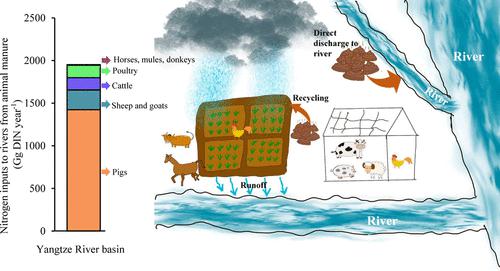当前位置:
X-MOL 学术
›
Environ. Sci. Technol.
›
论文详情
Our official English website, www.x-mol.net, welcomes your
feedback! (Note: you will need to create a separate account there.)
Nitrogen in the Yangtze River Basin: Pollution Reduction through Coupling Crop and Livestock Production
Environmental Science & Technology ( IF 10.8 ) Pub Date : 2022-11-29 , DOI: 10.1021/acs.est.1c08808 Xuanjing Chen 1, 2 , Mengru Wang 3 , Carolien Kroeze 3 , Xi Chen 3 , Lin Ma 4 , Xinping Chen 2 , Xiaojun Shi 2, 5 , Maryna Strokal 3
Environmental Science & Technology ( IF 10.8 ) Pub Date : 2022-11-29 , DOI: 10.1021/acs.est.1c08808 Xuanjing Chen 1, 2 , Mengru Wang 3 , Carolien Kroeze 3 , Xi Chen 3 , Lin Ma 4 , Xinping Chen 2 , Xiaojun Shi 2, 5 , Maryna Strokal 3
Affiliation

|
Livestock production poses a threat to water quality worldwide. A better understanding of the contribution of individual livestock species to nitrogen (N) pollution in rivers is essential to improve water quality. This paper aims to quantify inputs of dissolved inorganic nitrogen (DIN) to the Yangtze River from different livestock species at multiple scales and explore ways for reducing these inputs through coupling crop and livestock production. We extended the previously developed model MARINA (Model to Assess River Input of Nutrient to seAs) with the NUFER (Nutrient flows in Food chains, Environment, and Resource use) approach for livestock. Results show that DIN inputs to the Yangtze River vary across basins, sub-basins, and 0.5° grids, as well as across livestock species. In 2012, livestock production resulted in 2000 Gg of DIN inputs to the Yangtze River. Pig production was responsible for 55–85% of manure-related DIN inputs. Rivers in the downstream sub-basin received higher manure-related DIN inputs than rivers in the other sub-basins. Around 20% of the Yangtze basin is considered as a manure-related hotspot of river pollution. Recycling manure on cropland can avoid direct discharges of manure from pig production and thus reduce river pollution. The potential for recycling manure is larger in cereal production than in other crop species. Our results can help to identify effective solutions for coupling crop and livestock production in the Yangtze basin.
中文翻译:

长江流域氮素:农牧结合减排
畜牧业生产对全世界的水质构成威胁。更好地了解单个牲畜物种对河流中氮 (N) 污染的贡献对于改善水质至关重要。本文旨在量化多尺度不同牲畜物种向长江输入的溶解性无机氮 (DIN),并探索通过耦合农作物和畜牧生产来减少这些输入的方法。我们使用 NUFER(食物链、环境和资源利用中的养分流动)方法扩展了先前开发的模型 MARINA(评估河流向 seAs 输送养分的模型)。结果表明,输入到长江的 DIN 因流域、次流域和 0.5° 网格以及牲畜种类而异。在2012年,畜牧业生产导致 2000 Gg DIN 输入长江。生猪生产占与粪便相关的 DIN 输入的 55-85%。下游子流域的河流接收到的与粪便相关的 DIN 输入高于其他子流域的河流。大约 20% 的长江流域被认为是与粪便相关的河流污染热点地区。农田循环利用粪肥可以避免养猪场粪便直接排放,减少河流污染。与其他作物品种相比,谷物生产中循环利用粪便的潜力更大。我们的研究结果有助于确定长江流域作物和畜牧业耦合生产的有效解决方案。下游子流域的河流接收到的与粪便相关的 DIN 输入高于其他子流域的河流。大约 20% 的长江流域被认为是与粪便相关的河流污染热点地区。农田循环利用粪肥可以避免养猪场粪便直接排放,减少河流污染。与其他作物品种相比,谷物生产中循环利用粪便的潜力更大。我们的研究结果有助于确定长江流域作物和畜牧业耦合生产的有效解决方案。下游子流域的河流接收到的与粪便相关的 DIN 输入高于其他子流域的河流。大约 20% 的长江流域被认为是与粪便相关的河流污染热点地区。农田循环利用粪肥可以避免养猪场粪便直接排放,减少河流污染。与其他作物品种相比,谷物生产中循环利用粪便的潜力更大。我们的研究结果有助于确定长江流域作物和畜牧业耦合生产的有效解决方案。与其他作物品种相比,谷物生产中循环利用粪便的潜力更大。我们的研究结果有助于确定长江流域作物和畜牧业耦合生产的有效解决方案。与其他作物品种相比,谷物生产中循环利用粪便的潜力更大。我们的研究结果有助于确定长江流域作物和畜牧业耦合生产的有效解决方案。
更新日期:2022-11-29
中文翻译:

长江流域氮素:农牧结合减排
畜牧业生产对全世界的水质构成威胁。更好地了解单个牲畜物种对河流中氮 (N) 污染的贡献对于改善水质至关重要。本文旨在量化多尺度不同牲畜物种向长江输入的溶解性无机氮 (DIN),并探索通过耦合农作物和畜牧生产来减少这些输入的方法。我们使用 NUFER(食物链、环境和资源利用中的养分流动)方法扩展了先前开发的模型 MARINA(评估河流向 seAs 输送养分的模型)。结果表明,输入到长江的 DIN 因流域、次流域和 0.5° 网格以及牲畜种类而异。在2012年,畜牧业生产导致 2000 Gg DIN 输入长江。生猪生产占与粪便相关的 DIN 输入的 55-85%。下游子流域的河流接收到的与粪便相关的 DIN 输入高于其他子流域的河流。大约 20% 的长江流域被认为是与粪便相关的河流污染热点地区。农田循环利用粪肥可以避免养猪场粪便直接排放,减少河流污染。与其他作物品种相比,谷物生产中循环利用粪便的潜力更大。我们的研究结果有助于确定长江流域作物和畜牧业耦合生产的有效解决方案。下游子流域的河流接收到的与粪便相关的 DIN 输入高于其他子流域的河流。大约 20% 的长江流域被认为是与粪便相关的河流污染热点地区。农田循环利用粪肥可以避免养猪场粪便直接排放,减少河流污染。与其他作物品种相比,谷物生产中循环利用粪便的潜力更大。我们的研究结果有助于确定长江流域作物和畜牧业耦合生产的有效解决方案。下游子流域的河流接收到的与粪便相关的 DIN 输入高于其他子流域的河流。大约 20% 的长江流域被认为是与粪便相关的河流污染热点地区。农田循环利用粪肥可以避免养猪场粪便直接排放,减少河流污染。与其他作物品种相比,谷物生产中循环利用粪便的潜力更大。我们的研究结果有助于确定长江流域作物和畜牧业耦合生产的有效解决方案。与其他作物品种相比,谷物生产中循环利用粪便的潜力更大。我们的研究结果有助于确定长江流域作物和畜牧业耦合生产的有效解决方案。与其他作物品种相比,谷物生产中循环利用粪便的潜力更大。我们的研究结果有助于确定长江流域作物和畜牧业耦合生产的有效解决方案。











































 京公网安备 11010802027423号
京公网安备 11010802027423号